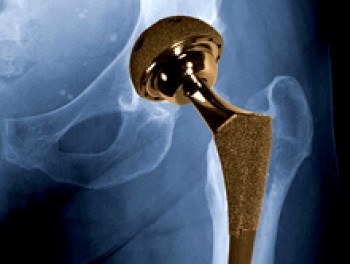Body Produces “Industrial” Lubricant for Metal Hip Implants
Body Produces “Industrial” Lubricant for Metal Hip Implants
A lubricating layer made of graphitic carbon naturally forms in the joints of metal-on-metal hip implants, a new study shows. This solid layer, produced within the body, is more like an industrial lubricant than joint fluid. The finding may help researchers design longer-lasting metal-on-metal hips for treating arthritis and other joint disorders.
Arthritis is a painful condition often characterized by inflammation of the joints. It’s a common cause of disability in people as they age. The inflammation in an arthritic joint can damage tissue and bone, eventually making the joint extremely painful. To treat the condition, surgeons resurface or replace the joint with an implant.

X-ray of the hip region with a metal-on-metal implant superimposed.
The most common hip implants are made of metal and polyethylene, a form of plastic. Over time, however, metal and plastic joints wear down, and broken-off bits can damage the remaining bone and tissue of the hip. Over the last 10 years, all-metal joints have become increasingly popular, as they are generally more stable and durable. In some cases, however, metal-on-metal implants can still shed damaging metal debris through wear and corrosion.
Metal-on-metal joints aren’t designed with lubrication but, with use, a thin layer appears in the joint between the ball and socket. This layer, which forms between the 2 rubbing metal faces, is known as a tribological layer. Researchers initially thought that it was made of proteins and other biological material, like the lubrication in a normal joint.
Dr. Joshua Jacobs of Rush University Medical Center and Dr. Laurence Marks of Northwestern University organized a research team to investigate the makeup of the tribological layer. Their study, funded by NIH’s National Institute of Arthritis and Musculoskeletal and Skin Diseases (NIAMS) appeared in the December 23, 2011, issue of Science.
The researchers examined the tribological layer on 7 all-metal joints that had been removed from patients. They scraped off a bit of the layer and analyzed it by electron energy loss spectroscopy, a method that reveals the type of atoms present in a material. To their surprise, they discovered that the layer was made up in large part of graphitic carbon, with very little, if any, protein.
“Knowing that the structure is graphitic carbon really opens up the possibility that we may be able to manipulate the system,” says coauthor Dr. Alfons Fisher of the University of Duisburg-Essen, Germany. “We now have a target for how we can improve the performance of these devices.”
With these insights, researchers can aim to create safer, longer-lasting hip implants by encouraging graphitic carbon to stick to the metal of the implant.
###
* The above story is reprinted from materials provided by National Institutes of Health (NIH)
** The National Institutes of Health (NIH) , a part of the U.S. Department of Health and Human Services, is the nation’s medical research agency—making important discoveries that improve health and save lives. The National Institutes of Health is made up of 27 different components called Institutes and Centers. Each has its own specific research agenda. All but three of these components receive their funding directly from Congress, and administrate their own budgets.




















